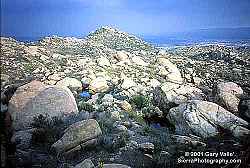| |
Ponds
and Pictographs
Monday, February 19,
2001
Copyright © 2001 Gary Valle'. All Rights Reserved. |
 
Rocky Peak, February
2001
|
Sometimes it is good not to have
a plan. It leaves you free to follow intuition, impulse, and
observation. One of the rewards can be unexpected discoveries
or revelations.
Popular among hikers and mountain bikers, Rocky Peak is
located north of the pass that separates the San Fernando
Valley from Simi Valley, along the border of Los Angeles
and Ventura Counties.
|
The peak is comprised of uplifted
sandstone strata created from material from turbidity flows
originating along the submarine continental shelf, many millions
of years ago. The sandstone forms broken ridges with steep
south faces, and many large boulders. There is a fire road
along the spine of the peak, with several trails joining the
road along its length. Recently, while running one of these
trails, the impulse of exploration struck, and I found myself
trekking upward along a prominent ridge. |
Part way up the ridge, I came
across this rattlesnake/spiral
motif pictograph. The next two weeks I would run all over
Rocky Peak and the Simi Hills comparing this painting to known
examples of modern, and indigenous paintings.
Based on these comparisons, research, and discussions with
an expert, this painting is probably modern. The type of
paint and style of artwork appears to be similar to modern
paintings found elsewhere on the peak. In addition, the
rattlesnake/spiral motif would be unusual for native rock
art in this area.
|
 
Pictograph (prob.
modern origin) Rocky Peak, Feb 2001
|
 
Pond on Rocky Peak,
Feb 2001
|
A very good overview of the rock art of California
can be found in The
Art of the Shaman : Rock Art of California, by David S.
Whitley.
Continuing up the ridge, I eventually reached a plateau-
like high point covered with a jumble of huge boulders.
Interspersed among the boulders was a number of large
ponds. This was startling for an area that receives
only about 16 inches of rain a year! You don't normally
associate chaparral covered mountain tops with large areas
of standing water. |
One explanation is that the dip
of the strata tends to capture water on the favorable north
sides of the large boulders. I would never have guessed vernal
pools of this size would, or could, exist in this area.
Although they are not perennial, weathering suggests they
do recur from year to year. It will be interesting to see
how long they last, and in what conditions they recur.
Additional Notes
As of March 12, 2002, Los Angeles is more than 8 inches
below a normal value of about 12 inches of rainfall. (Measured
since July 1.) The Rocky Peak area has received only about
1 - 2 inches of rain since January 1, 2002. On a recent exploration
of the area I found no pools; only damp patches where the
pools should be. |
|




